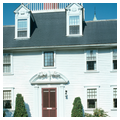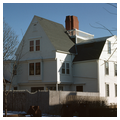You are here
St. John the Evangelist Rectory (John Dennis House)
Directly across the street from the Robinson house is yet another eighteenth-century gambrel with the same two-story formula, this one more compact, with a central chimney (rather than the spaced interior chimneys of the preceding examples) emphasized by later dormers and a railed platform built around the chimney. Features include the replica of the door to the Hunter House ( NE12) and another Neo-Colonial interior remodeling by McKim, also commissioned by Benjamin Smith, who owned this house too. The commission this time called for a new entrance hall for daily use, with a sitting room to the rear of the old house. McKim's work here related to his publication, in the New-York Sketch-book of Architecture, of the picturesque dilapidation of Bishop Berkeley's neglected Whitehall (in Middletown) and coincided with the year of the Philadelphia Centennial Exposition, whose various Colonial Revival buildings gave the style wide publicity. It was McKim who adorned his new addition with the garden door frame of the nearby Hunter House.
Writing Credits
If SAH Archipedia has been useful to you, please consider supporting it.
SAH Archipedia tells the story of the United States through its buildings, landscapes, and cities. This freely available resource empowers the public with authoritative knowledge that deepens their understanding and appreciation of the built environment. But the Society of Architectural Historians, which created SAH Archipedia with University of Virginia Press, needs your support to maintain the high-caliber research, writing, photography, cartography, editing, design, and programming that make SAH Archipedia a trusted online resource available to all who value the history of place, heritage tourism, and learning.

















